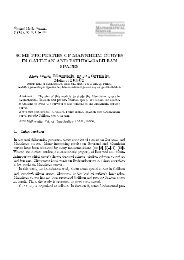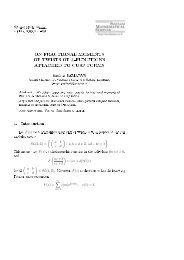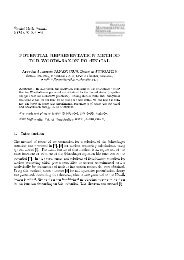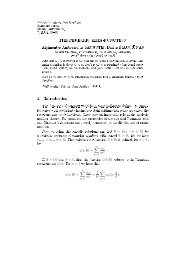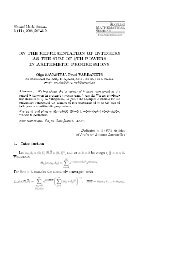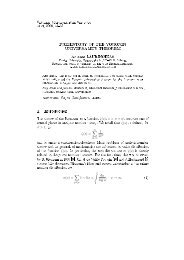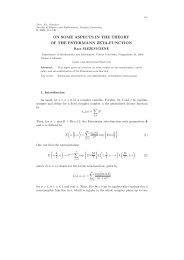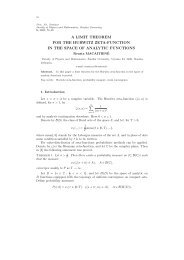A BICOMPLEX HURWITZ ZETA-FUNCTION 1. Introduction
A BICOMPLEX HURWITZ ZETA-FUNCTION 1. Introduction
A BICOMPLEX HURWITZ ZETA-FUNCTION 1. Introduction
Create successful ePaper yourself
Turn your PDF publications into a flip-book with our unique Google optimized e-Paper software.
’iauliai Mathematical Seminar1(9), 2006, 2331A <strong>BICOMPLEX</strong> <strong>HURWITZ</strong> <strong>ZETA</strong>-<strong>FUNCTION</strong>Algirdas JAVTOKASVilnius University, Naugarduko 24, LT03225, Vilnius, Lithuania;e-mail: ajavtokas@math.comAbstract. In the paper, we use a commutative generalization of complexnumbers, called bicomplex numbers, to introduce a holomorphic Hurwitzzeta-function of two complex variables satisfying the complexied Cauchy-Riemann equations.Key words and phrases: bicomplex numbers, Hurwitz zeta-function, quaternions.Mathematics Subject Classication: 11M35, 11R52, 11M4<strong>1.</strong><strong>1.</strong> <strong>Introduction</strong>There exist several ways to generalize complex numbers into a real algebra ofdimension four. It seems that perhaps only quaternions ([1], [2], [3], [11], [12])and bicomplex numbers ([4], [7], [8]) enable us to dene well analysis withsuch kind of generalizations. Quaternions are not commutative instead ofbicomplex numbers which are commutative but with zero divisors. However,there exist a denition of a quaternionic Riemann zeta-function using theDirichlet series (see [13]).Let us introduce some of the basic results of the theory of bicomplexnumbers. In 1982, Corrado Segre published a paper [9] in which he treatedan innite family of algebras whose elements are called bicomplex numbers,tricomplex numbers, ..., n-complex numbers. We dene bicomplex numbers(also called tetranumbers) as follows:T := {a + bi 1 + ci 2 + dj : i 2 1 = i 2 2 = −1, j 2 = 1,i 2 j = ji 2 = −i 1 , i 1 j = ji 1 = −i 2 , i 2 i 1 = i 2 j = j},where a, b, c, d ∈ R. The topology used on T is the topology of R 4 inducedby the Euclidean norm (also noted | |).
24 A. JavtokasWe can write a bicomplex number a+bi 1 +ci 2 +dj as (a+bi 1 )+(c+di 1 )i 2 =z 1 +z 2 i 2 , where z 1 , z 2 ∈ C(i 1 ) := {x+yi 1 : i 2 1 = −1}. Thus, T can be viewedas a kind of duplication of C(i 1 ). In particular, a bicomplex number canbe seen as an element of C ≃ C 2 (i 1 ). It is easy to see [4] that T is acommutative unitary ring with the following characterization for the noninvertibleelements.Proposition <strong>1.</strong> Let ω = a + bi 1 + ci 2 + dj ∈ T. Then ω is non-invertible ifand only if(a = −d and b = c) or (a = d and b = −c).It is also possible to dene dierentiability of a function at a point of T[4].Definition <strong>1.</strong> Let U be an open set of T and ω 0 ∈ U. Then f : U ⊆ T → Tis said to be T-dierentiable at ω 0 with derivative equal to f ′ (ω 0 ) ∈ T iff(ω) − f(ω 0 )lim= f ′ (ωω→ω 0 ).0 ω − ω 0(ω−ω 0 inv.)We also say that the function f is T-holomorphic on an open set U ifand only if f is T-dierentiable at each point of U.As we have seen, a bicomplex number can be considered as an elementof C 2 , so a function f(z 1 + z 2 i 2 ) = f 1 (z 1 , z 2 ) + f 2 (z 1 , z 2 )i 2 of T can beseen as a mapping f(z 1 , z 2 ) = (f 1 (z 1 , z 2 ), f 2 (z 1 , z 2 )) of C 2 . Here we have acharacterization of such mappings. Firstly, let us denotedetJ f (ω) =∣∂f 1 ∂f 1∂z 1 ∂z 2∂f 2 ∂f 2∂z 1∂z 2∣ ∣∣∣∣.Theorem <strong>1.</strong> Let U be an open set and let f : U ⊆ T → T be such thatf ∈ C 1 (U). Moreover, suppose that f(z 1 + z 2 i 2 ) = f 1 (z 1 , z 2 ) + f 2 (z 1 , z 2 )i 2 .Then f is T-holomorphic on U if and only if f 1 and f 2 are holomorphic inz 1 and z 2 and,∂f 1∂z 1= ∂f 2∂z 2on U. Moreover, f ′ = ∂f 1detJ f (ω) ≠ 0.∂z 2+ ∂f 2and∂f 2∂z 1= ∂f 1∂z 2∂z 1i 2 and f ′ (ω) is invertible if and only if
A bicomplex Hurwitz zeta-function 25This theorem can be obtained from results in [4]. Moreover, by the Hartog'stheorem [10], it is possible to show that f ∈ C 1 (U) can be droppedfrom the hypotheses. Hence, it is natural to dene the corresponding classof mappings for C 2 .Definition 2. The class of T-holomorphic mappings on an open set U ⊆ C 2is dened as followsT H(U) :={f : U ⊆ C 2 → C 2 |f ∈ H(U)and∂f 1∂z 1= ∂f 2∂z 2,∂f 2= ∂f }1on U .∂z 1 ∂z 2T H(U) is the subclass of holomorphic mappings of C 2 satisfying thecomplexied Cauchy-Riemann equations.We remark that f ∈ T H(U) in terms of C 2 if and only if f is T-dierentiable on U. It is also important to know that every bicomplex numberz 1 + z 2 i 2 has the following unique idempotent representation. Let e 1 = 1+j2and e 2 = 1−j2, thenz 1 + z 2 i 2 = (z 1 − z 2 i 1 )e 1 + (z 1 + z 2 i 1 )e 2 .This representation is very useful because addition, multiplication and divisioncan be done term-by-term. Also, an element will be non-invertible ifand only if z 1 − z 2 i 1 = 0 or z 1 + z 2 i 1 = 0.The notion of holomorphicity can also be seen with this kind of notation.For this, we need to dene the projections P 1 , P 2 : T → C(i 1 ) as P 1 (z 1 +z 2 i 2 ) = z 1 −z 2 i 1 and P 2 (z 1 +z 2 i 2 ) = z 1 +z 2 i 1 . Also, let us dene T-Cartesianproduct byX 1 × e X 2 := {z 1 + z 2 i 2 ∈ T : z 1 + z 2 i 2 = ω 1 e 1 + ω 2 e 2 , (ω 1 , ω 2 ) ∈ X 1 × X 2 }.Definition 3. We say that X ⊆ T is a T-Cartesian set determined by X 1and X 2 if X = X 1 × e X 2 .In [4] it is shown that if X 1 and X 2 are domains of C(i 1 ), then X 1 × e X 2is also a domain of T. Now, it is possible to state the following theorems [4].Theorem 2. If f e1 : X 1 → C(i 1 ) and f e2 : X 2 → C(i 1 ) are holomorphicfunctions of C(i 1 ) on the domains X 1 and X 2 , respectively, then the functionf : X 1 × e X 2 → T dened byf(z 1 + z 2 i 2 ) = f e1 (z 1 − z 2 i 1 )e 1 + f e2 (z 1 + z 2 i 1 )e 2 ,
26 A. Javtokasfor all z 1 + z 2 i 2 ∈ X 1 × e X 2 , is T-holomorphic on the domain X 1 × e X 2 , andf ′ (z 1 + z 2 i 2 ) = f ′ e1(z 1 − z 2 i 1 )e 1 + f ′ e2(z 1 + z 2 i 1 )e 2 .for all z 1 + z 2 i 2 ∈ X 1 × e X 2 .Theorem 3. Let X be a domain in T, and let f : X → T be a T-holomorphicfunction on X. Then there exist holomorphic functions f e1 : X 1 → C(i 1 ) andf e2 : X 2 → C(i 1 ) with X 1 = P 1 (X) and X 2 = P 2 (X) such thatf(z 1 + z 2 i 2 ) = f e1 (z 1 − z 2 i 1 )e 1 + f e2 (z 1 + z 2 i 1 )e 2for all z 1 + z 2 i 2 ∈ X. We also note that X 1 and X 2 are also domains ofC(i 1 ).The bicomplex Riemann zeta-function was rst dened in [6]. Let ω =z 1 + z 2 i 2 ∈ T with Re(z 1 ) > 1 and |Im(z 2 )| 1 and xed α, 0 < α 1, is dened byζ(s, α) =∞∑m=01(m + α) s .In this paper, we introduce a Hurwitz zeta-function for bicomplex numbers.More precisely, we obtain a holomorphic Hurwitz zeta-function of two complexvariables satisfying the complexied Cauchy-Riemann equations.2. Bicomplex Hurwitz zeta-functionIn this section, we dene an expression∞∑n=01(n + α) ω ,where ω is a bicomplex number. For this, we need the following denition.
A bicomplex Hurwitz zeta-function 27Definition 4. Let n ∈ N\{0}, 0 < α 1 and ω = z 1 + z 2 i 2 ∈ T. We denewhere(n + α) ω := e ω·log(n+α) ,e z 1+z 2 i 2:= e z1 · e z 2i 2and e z 2i 2:= cos(z 2 ) + i 2 sin(z 2 ).By Denition 4,(n + α) z 1+z 2 i 2= e z 1·log(n+α) · (cos(z 2 · log(n + α)) + i 2 sin(z 2 · log(n + α))) .Remark A (see [4]).1 ◦ e ω 1+ω 2= e ω1 · e ω 2for all ω 1 , ω 2 ∈ T;2 ◦ e ω is invertible for all ω ∈ T;3 ◦ e z 1+z 2 i 2= (e z 1−z 2 i 1)e 1 + (e z 1+z 2 i 1)e 2 for all z 1 + z 2 i 2 ∈ T.Now we are able to dene a bicomplex Hurwitz zeta-function.Definition 5. Let ω = z 1 + z 2 i 2 ∈ T with Re (z 1 ) > 1 and |Im (z 2 )| 1 and Re (z 1 +z 2 i 1 ) > <strong>1.</strong> Then the seriesconverges, and∞∑n=0Moreover,[ ∞1(n + α) ω = ∑n=0∞∑n=01(n + α) ω] [1∑ ∞(n + α) z 1−z 2 i 1e 1 +n=0]1(n + α) z 1+z 2 i 1e 2 .{ω ∈ T : Re (z 1 − z 2 i 1 ) > 1 and Re (z 1 + z 2 i 1 ) > 1}= {ω ∈ T : Re (z 1 ) > 1 and |Im (z 2 )| < Re (z 1 ) − 1}.
28 A. JavtokasProof. From the last remarks we obtain that(n + α) z 1+z 2 i 2= (n + α) (z 1−z 2 i 1 )e 1 +(z 1 +z 2 i 1 )e 2is invertible, hence,1(n + α) z 1+z 2 i 2== e ((z 1−z 2 i 1 )e 1 +(z 1 +z 2 i 1 )e 2 ) log(n+α)= e (z 1−z 2 i 1 ) log(n+α)e 1 +(z 1 +z 2 i 1 ) log(n+α)e 2= e (z 1−z 2 i 1 ) log(n+α) e 1 + e (z 1+z 2 i 1 ) log(n+α) e 2= (n + α) z 1−z 2 i 1e 1 + (n + α) z 1+z 2 i 1e 21(n + α) z 1−z 2 i 1e 1 +1(n + α) z 1+z 2 i 1e 2 .Now, from the theory of the Hurwitz zeta-function of one complex variable,it is well known that the series∞∑n=01(n + α) sconverges absolutely in the half-plane Re(s) > <strong>1.</strong> Therefore, the seriesand∞∑n=0∞ ∑n=01(n + α) z 1−z 2 i 11(n + α) z 1+z 2 i 1converge for Re (z 1 − z 2 i 1 ) > 1 and Re (z 1 + z 2 i 1 ) > 1, respectively. Hence,∞∑n=0[ ∞]1(n + α) ω = ∑ 1(n + α) z 1−z 2 i 1e 1 +n=0[ ∞∑n=0]1(n + α) z 1+z 2 i 1e 2on {ω ∈ T : Re (z 1 − z 2 i 1 ) > 1 and Re (z 1 + z 2 i 1 ) > 1}. Moreover, letω = z 1 + z 2 i 2 = a + bi 1 + ci 2 + dj, i. e., z 1 = a + bi 1 and z 2 = c + di 1 . Then,Re (z 1 ) = a, Im (z 2 ) = d, Re (z 1 − z 2 i 1 ) = a + d and Re (z 1 + z 2 i 1 ) = a − d.Now, {ω ∈ T : Re (z 1 − z 2 i 1 ) > 1 and Re (z 1 + z 2 i 1 ) > 1} = {ω ∈ T :Re (z 1 ) > 1 and |Im (z 2 )| < Re (z 1 ) − 1}, sincea + d > 1 and a − d > 1 if and only if a > 1 and |d| < a − <strong>1.</strong>This completes the proof.
A bicomplex Hurwitz zeta-function 29Now we will determine the whole domain of existence of our bicomplexHurwitz zeta-function. In fact, if O 2 denotes the set of non-invertible elementsin T, we extend ζ(ω, α) as follows. For ω ∈ T \{1 + O 2 }ζ(ω, α) := ζ(z 1 − z 2 i 1 , α)e 1 + ζ(z 1 + z 2 i 1 , α)e 2 .Remark B (see [6]).1 ◦ 1 = 1e 1 + 1e 2 .2 ◦ ω ∈ 1 + O 2 if and only if z 1 − z 2 i 1 = 1 or z 1 + z 2 i 1 = <strong>1.</strong>The next theorems of this section will help us to understand better whywe choose the set T \{1 + O 2 } to dene analytic continuation of ζ(ω, α).Theorem 5. The set T \{1 + O 2 } is open and connected in C 2 .Proof can be found in [6].Theorem 6. The bicomplex Hurwitz zeta-function ζ(ω, α) is T-holomorphicon T \{1 + O 2 }.Proof. Let f e1 (z 1 − z 2 i 1 ) = ζ(z 1 − z 2 i 1 , α) and f e2 (z 1 + z 2 i 1 ) = ζ(z 1 +z 2 i 1 , α) on X 1 = X 2 = C(i 1 )\{1}. Now, by analytic continuation, theHurwitz zeta-function is holomorphic on C(i 1 )\{1} and, by Theorem 2,ζ(ω, α) = f e1 (z 1 − z 2 i 1 )e 1 + f e2 (z 1 + z 2 i 1 )e 2 is a T-holomorphic mapping onthe domain X 1 × e X 2 = (C(i 1 )\{1} × e C(i 1 )\{1}) = T \{1+O 2 }. Therefore,ζ(ω, α) ∈ T H(T \{1 + O 2 }).Theorem 7. The analytic continuation ofζ(ω, α) =∞∑n=01(n + α) ωon T \{1 + O 2 } is unique.Proof. In view of Theorems 5 and 6, the function ζ(ω, α) := ζ(z 1 −z 2 i 1 , α)e 1 + ζ(z 1 + z 2 i 1 , α)e 2 is, in particular, holomorphic on the open andconnected set T \{1 + O 2 }. Hence, by the identity theorem of C 2 (see [5]),the analytic continuation of∞∑n=01(n + α) ωfrom the nonempty open set {ω ∈ T : Re (z 1 ) > 1 and |Im (z 2 )| < Re (z 1 )−1}to T \{1 + O 2 } must be unique. In particular, ζ(ω) := ζ(z 1 − z 2 i 1 , α)e 1 +
30 A. Javtokasζ(z 1 + z 2 i 1 , α)e 2 is the only one possible T-holomorphic continuation. Thiscompletes the proof.Finally, the following theorem conrms that the domain T \{1 + O 2 } isthe best possible.Theorem 8. Let ω 0 ∈ 1 + O 2 , thenlim |ζ(ω, α)| = ∞.ω→ω 0(ω /∈1+O 2 )Proof. Let ω = (z 1 −z 2 i 1 )e 1 +(z 1 +z 2 i 1 )e 2 and ω 0 = (z 0 1 −z0 2 i 1)e 1 +(z 0 1 +z 0 2 i 1)e 2 . By hypothesis, ω 0 ∈ 1 + O 2 . Hence, z 0 1 − z0 2 i 1 = 1 or z 0 1 + z0 2 i 1 = <strong>1.</strong>Without loss of generality, let us suppose that z 0 1 − z0 2 i 1 = <strong>1.</strong> Now, from theidentity (see [4])( |z1 − z 2 i 1 | 2 + |z 1 + z 2 i 1 | 2 ) 1/2|z 1 + z 2 i 2 | =,2it follows that if, for all z 1 + z 2 i 2 ∈ T, ω → ω 0 then z 1 − z 2 i 1 → 1 andz 1 + z 2 i 1 → z 0 1 − z0 2 i <strong>1.</strong> Moreover, ζ(s, α) is meromorphically continuable tothe whole complex plane with only a simple pole at s = <strong>1.</strong> Therefore,Thenlim |ζ(z 1 − z 2 i 1 , α)| = ∞.z 1 −z 2 i 1 →1limω→ω 0|ζ(ω, α)| = limω→ω 0|ζ(z 1 − z 2 i 1 , α)e 1 + ζ(z 1 + z 2 i 1 , α)e 2 |(ω /∈1+O 2 )(ω /∈1+O 2 )( |ζ(z1 − z 2 i 1 , α)| 2 + |ζ(z 1 + z 2 i 1 , α)| 2= limω→ω 02(ω /∈1+O 2 )= ∞.This completes the proof.) 1/2Acknowledgements. The author is partially supported by Grant fromLithuanian Foundation of Studies and Science.
A bicomplex Hurwitz zeta-function 31References[1] R. Fueter, Analytische Funktionen einer Quaternionen Variablen, CommentMath. Helv. 4 (1932), 920.[2] G. Moisil, Sur les quaternions monogenes, Bull. Sci. Math. Paris 55, No 2(1931), 169194.[3] G. Moisil and N. Theodoresco, Functions holomorphes dans l'espace, Mathematica(Cluj) 5 (1931), 142159.[4] G. B. Price, An <strong>Introduction</strong> to Multicomplex Spaces and Functions, MarcelDekker, New York, 199<strong>1.</strong>[5] R. M. Range, Holomorphic Functions and Integral Representations in SeveralComplex Variables, Springer, New York, 1986.[6] D. Rochon, A bicomplex Riemann zeta function, Tokyo J. Math. 27, No.2(2004), 357369.[7] D. Rochon, A bloch constant for hyperholomorphic functions, Complex Variables44 (2001), 8510<strong>1.</strong>[8] J. Ryan, Complexied Cliord analysis, Complex Variables 1 (1982), 119149.[9] G. Serge, La rappresentazioni reali delle forme complesse a gli enti iperalgebrici,Math. Ann. 40 (1892), 413467.[10] B. V. Shabat, <strong>Introduction</strong> to Complex Analysis part II: Functions of SeveralVariables, Translation of Math. Monographs, Vol. 110, AMS, Providence,1992.[11] M. V. Shapiro and N. L. Vasilevski, Quaternionic ψ-hyperholomorphicfunctions, singular integral operators and boundary value problems. I. ψ-hyperholomorphic function theory, Complex Variables 27 (1995), 1746.[12] M. V. Shapiro and N. L. Vasilevski, Quaternionic ψ-hyperholomorphic functions,singular integral operators and boundary value problems. II. Algebrasof singular integral operators and Riemann type boundary value problems,Complex Variables 27 (1995), 6796.[13] H. Shimizu, On zeta functions of quaternion algebras, Ann. of Math. 81(1965), 166193.Received27 September 2006



